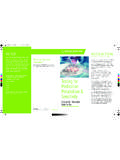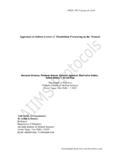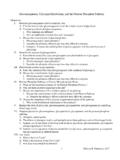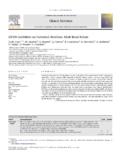Transcription of CHAPTER4
1 *CHAPTER 4 Pathophysiologyand differential diagnosisof anaemiaJean-Fran ois Lambert, Photis (108-141):EBMT2008 4-12-2009 16:05 Pagina 1081. Definition and classification of anaemiasAnaemia is a common condition, particularly in young women and in the geriatricpopulation, and is a significant public health problem in developing is defined by the World Health Organisation as haemoglobin (Hb) < 120g/L in women and Hb < 130 g/L in men. This definition also includes the so-calledpseudo anaemic states (pregnancy, cardiac heart failure and hyperproteinaemia) whereHb concentration falls as the result of an increase of the plasma volume. Incontrast, a decreased red blood cell mass can be masked by haemoconcentrationresulting from a decrease in plasma deficiency is the most frequent cause of anaemia, closely followed by anaemiaof chronic disease (Figure 1).There are a number of different ways of classifying anaemia.
2 Until recentlyclassification was based on the red blood size (MCV), but since the introduction ofthe automated reticulocyte count, which provides an easy way to assess red bloodcell (RBC) regeneration, one can now differentiate between hyporegenerative andregenerative anaemia. Basically, the measurement of reticulocytes will inform theclinician whether anaemia is due to a central defect of RBC production or toaccelerated destruction (Table 1). For the hyporegenerative group of anaemias, theMCV value remains important in differential Hyporegenerative anaemiasAs defined by reticulocyte count, hyporegenerative or aregenerative anaemia is presentDISORDERS OF ERYTHROPOIESIS,ERYTHROCYTES AND IRON METABOLISM109 CHAPTER 4 Pathophysiology and differential diagnosis of anaemiaFigure 1:Main causes of anaemiaRef. (1) deficiencyChronic diseaseAcute (108-141):EBMT2008 4-12-2009 16:05 Pagina 109when reticulocytes are less than 50x109/L in absolute value (% reticulocytes x RBCnumber).
3 This is always due to a deficient bone marrow production of Aplastic anaemiaAplastic anaemia is a rare disease resulting from marrow failure, involving not onlyred cell precursors, but more primitive progenitors or multipotent stem cells, andusually presents with anaemia associated with a variable decrease of WBC andplatelets (pancytopenia). It is defined by a severely hyporegenerative anaemia withpancytopenia. Aplastic anaemia is described in details by P Scheinberg and NYoung in chapter 6 of this Pure red cell aplasia (PRCA)PRCA can be classified as a subgroup of aplastic anaemia as it also involves marrowfailure, but only RBC production is affected. The reason to classify it as a separateentity is that PRCA is frequently associated with parvovirus B19 infection, usuallynot involving the other blood lineages. PRCA can also be associated with otherinfections, such as cytomegalovirus (CMV), HIV and hepatitis, or may occur as aconsequence of drug toxicity or the development of neutralising antibodies toerythropoietin (see below).
4 Myelodysplastic syndrome (MDS) results from a clonal defect affecting thehaematopoietic stem cells. The presentation of MDS can be similar to that ofTHE HANDBOOK2009 EDITION110 HyporegenerativeRegenerativeAplastic anaemiaHaemolysisPure red cell aplasiaImmuneMyelodysplastic syndromeNon-immuneDeficiency states Congenital: membrane, SS, thalassaemia, Ironenzymopathies, unstable Hb Vitamins Acquired: PNH, drugs (Pb, Zn and Cupoisoning), microangiopathy, hypersplenismMarrow infiltration/fibrosisHaemorrhage (bleeding)Inflammatory anaemia (anaemia of chronic disease)Erythropoietin underproductionTable 1:Classification of anaemiasHyporegenerative anaemia is defined as a reticulocyte count of < 50x109/L; regenerative anaemia is definedas a reticulocyte count of > 100x109/L. PNH: Paroxysmal nocturnal haemoglobinuria; SS: homozygoussickle cell disease. For reticulocyte count between 50 and 100x109/L, see Section 3: Practical approachto the anaemic (108-141):EBMT2008 4-12-2009 16:05 Pagina 110aplastic anaemia (pancytopenia), with refractory anaemia, neutropenia andthrombocytopenia, but a particular characteristic is the associated abnormalmaturation of all three cell lines defined as dysplasia, usually with a hypercellularmarrow and an increased level of intramedullary apoptosis (2).
5 In the peripheralblood, one usually sees macrocytic anisocytosis with poikilocytosis (abnormal RBCshapes), hyposegmented and hypogranular neutrophils sometimes showing a pseudoPelger-Hu t nuclear appearance (dumbbell-shaped bilobed nuclei), and variably sizedhypogranular platelets. This chronic condition often evolves to acute to the WHO classification 2008, the MDS syndromes comprise 7 nosologicalentities (3):1. Refractory anaemia (RA)2. Refractory anaemia with ringed sideroblasts (RARS)3. Refractory cytopenia with multilineage dysplasia (RCMD) with or without ringedsideroblasts4. Refractory anaemia with excess blasts 1 (RAEB1, 5-9% marrow blasts)5. Refractory anaemia with excess blasts 2 (RAEB2, 10-19% marrow blasts orpresence of Auer's rods)6. Myelodysplastic syndrome unclassified7. MDS associated with isolated del(5q).Of these forms, sideroblastic anaemia will be treated separately in chapter of the 5q- syndrome follows in part 2 of the present recently, the percentage of blasts in the bone marrow was the only predictorof leukaemic transformation.
6 A new prognostic tool, the International PrognosticScore System (IPSS) has been devised based on the retrospective analysis of morethan 800 patients (4), and allowed the definition of three efficient prognostic criteriafor both overall survival and risk of leukaemic transformation. These criteria aremarrow blast percentage, bone marrow cytogenetics and the number of peripheralblood cytopenias (Tables 2and3). Deficiency anaemiasThese are the most frequently encountered anaemias. A useful marker is the RBCvolume (MCV), which indicates that there is either a nuclear maturation defect ora haemoglobin synthesis defect. In the former case, the impaired cell division processallows a normal intracellular haemoglobin concentration to be achieved after a lownumber of cell divisions thus resulting in macrocytosis. When haemoglobin synthesisis defective, the immature RBC will divide more times during the slower haemoglobinproduction process, thus resulting in microcytosis.
7 Vitamin B12 (cyanocobalamin)and folic acid deficiency will present with macrocytic features and iron deficiencywith microcytic OF ERYTHROPOIESIS,ERYTHROCYTES AND IRON METABOLISMCHAPTER 4 Pathophysiology and differential diagnosis of (108-141):EBMT2008 4-12-2009 16:05 Pagina 111 Iron deficiency remains the most common cause of microcytosis, followed byalpha/beta thalassaemia, Hb E and Hb C (5). Iron deficiency states will present withhyporegenerative and microcytic anaemia. Iron metabolism is finely tuned toregulate intestinal absorption and serum iron level. Iron deficiency is defined as alow serum iron, elevated transferrin iron binding capacity (as a response todeficiency) and low ferritin (reflecting low iron stores). Iron deficiency is very frequentin menstruating women and probably underestimated. Other aetiologies includechronic blood loss (gastrointestinal, phlebotomy), malabsorption (gastrectomy,achlorhydria) or increased needs (pregnancy, breast feeding).
8 The source of bloodloss should always be identified when investigating iron deficiency anaemia. Inyounger patients (<60 years old), the upper digestive tract should be investigatedfirst, while in older patients a colonoscopy may identify bleeding polyps orangiodysplastic lesions (affecting up to 3-5% of people above 60 years).It has recently become clear thatHelicobacter pyloriinfection is frequently associatedwith iron deficiency which is either refractory to iron treatment or relapses onceiron therapy is discontinued. Competition betweenHelicobacter pyloriand themicroorganisms responsible for iron absorption is thought to be the cause of ironTHE HANDBOOK2009 EDITION112 ScorePrognostic marrow blasts (%)< 55-10-11-20 KaryotypeGoodIntermediate-PoorCytopenias0-12-3 Table 2:International Prognostic Score System for MDSK aryotype: Good: normal, -Y, 5q-, 20q-; Poor: complex (>3 anomalies or chromosome 7); Intermediate:others.
9 Cytopenias: absolute neutrophil count < , Hb < 100 g/L, platelets < 100x109/L. Adaptedfrom (4).Combined Score Risk Category Frequency (%) Median survival Time to 25%(years)probability ofevolution to AML(years) 3:IPSS prognostic groupsFour prognostic categories are defined based on the IPPS. A clear separation is observed between groupsin terms of overall survival and risk of evolution to acute leukaemia. Adapted from (4). (108-141):EBMT2008 4-12-2009 16:05 Pagina 112depletion and of chronic gastritis (6-8).Progress in our knowledge about iron metabolism has led to the recognition of thehereditary forms of iron deficiency anaemias. Of these, two recently describedentities, mutations in the genes coding for DMT-1 and in matriptase -2 proteins willbe described in detail in the second part of the present vitamin B12 body stores are around 5 mg, which allows an individual to survive4-5 years without a supply of exogenous B12.
10 B12 is absorbed from animal productsonly in the terminal ileum and requires adequate amounts of gastric intrinsicfactor (9). Several conditions can lead to B12 deficiency: autoimmune gastritis(Biermer's or pernicious anaemia), partial or total gastrectomy, a diet poor inanimal or dairy products, in vegetarians and especially vegans (who eat neithereggs nor milk products), malabsorption states (chronic ileitis, ileal resection,bacterial overgrowth syndrome), drugs (proton pump inhibitors, metformin,cholestyramine). Despite being considered normal by many clinicians and laboratories,levels below 220 pmol/L should be considered low and should be supplemented,especially in elderly subjects (10). Atrophic gastritis is a frequent phenomenon inthe elderly and, in this population, is probably the main cause of B12 morphologic and haematologic features of folic acid deficiency are similar tothose of B12 deficiency.








